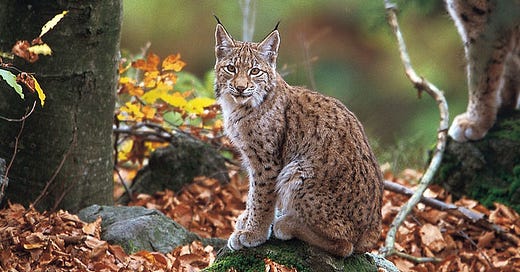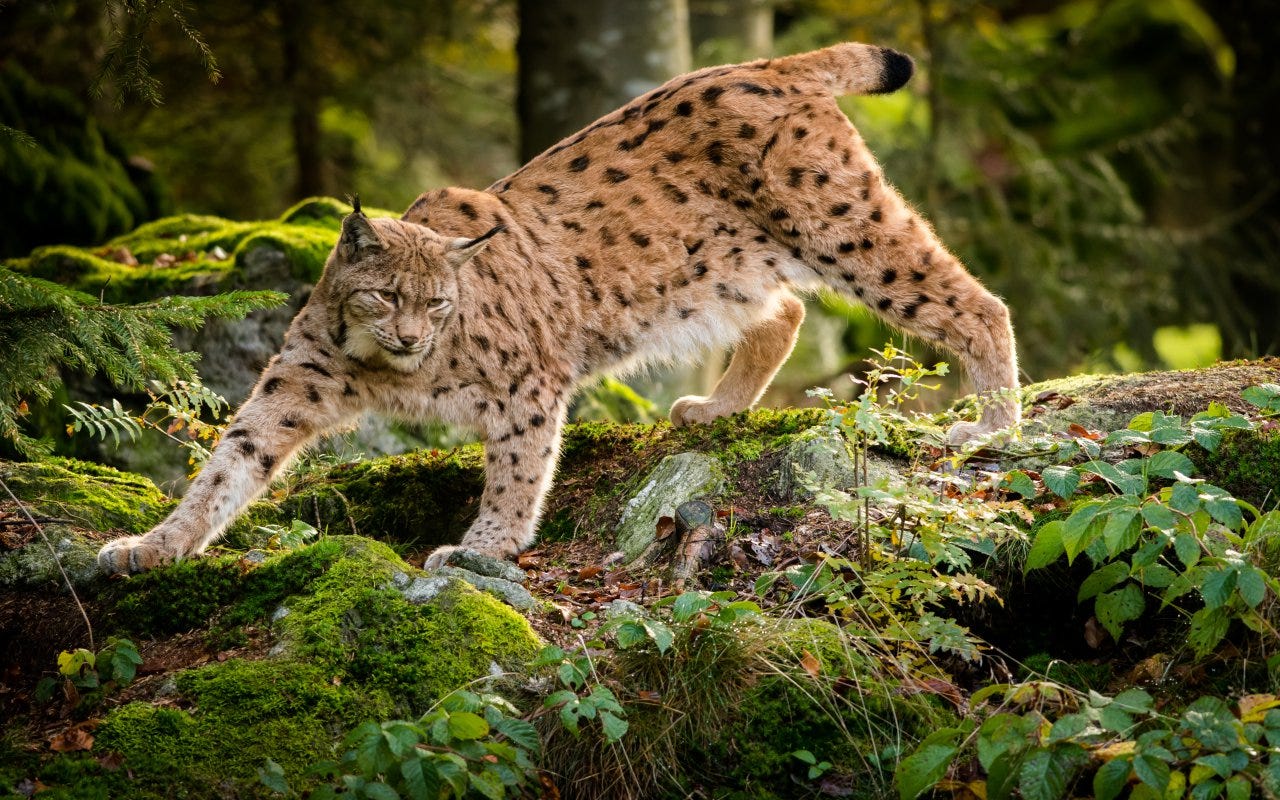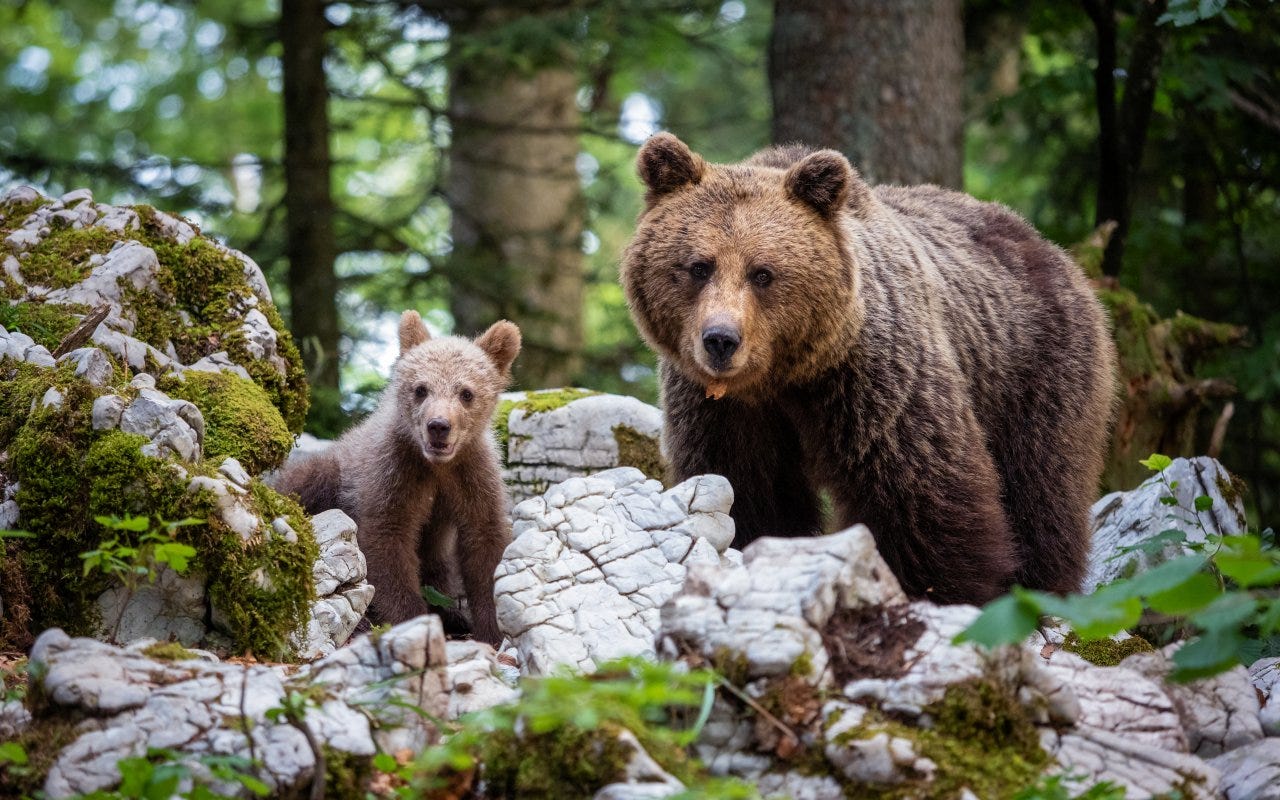S2E26. Endangered species
In a crucial stop for BarBalkans, we raise the alarm on species in danger of disappearing from the region: from the Balkan lynx to the Eastern imperial eagle and the slow return of brown bears
Hi,
welcome back to BarBalkans, the newsletter (and website) with blurred boundaries.
Before we get started, I would like to update you on a big change for this newsletter.
Since its birth, BarBalkans has always been a weekly newsletter. Every Saturday, at 8 a.m. sharp, as breakfast in bed.
From now on, things will be different.
BarBalkans will come out every other Saturday.
And not because I am tired of it, or because I have something else to do. Not at all, projects keep piling up!
BarBalkans will become a biweekly newsletter because a new parallel path is kicking off (following BarBalkans - Podcast, the time machine on the Yugoslav Wars, out every second Wednesday of the month).
I told you about it a few weeks ago, at the end of the farewell-stop to the President of the European Parliament, David Sassoli.
Preparations for “The Langer-Sassoli Project” have begun.
Every other Saturday - only on barbalcani.eu - we will find an analysis on specific topics that connected two great European men and politicians (linked to the Balkans): Alexander Langer and David Sassoli.
In short, one Saturday morning we will meet here, with our newsletter. One Saturday we will meet there, with the notebook of the new Project. And so on.
What do you say?
Let’s get back on the road, with even more enthusiasm than before!
Because today we already have to roll up our sleeves.
Lynxes (almost) without a future
We are talking about endangered species and, unfortunately, in the Balkan peninsula there are many.
The latest alarm regards one of the most fascinating animals: the Balkan lynx.
The Balkan Lynx Recovery Programme report revealed that in 2021 the 151 camera traps scattered throughout the region captured 1 lynx in Kosovo, 4 in Albania and 5 in North Macedonia.
Even if this Eurasian lynx subspecies is protected by all international wildlife conventions, there are only between 30 and 50 lynxes in this key-area, according to experts.
Poaching, intensive hunting of prey and degradation of the natural habitat are the main causes of the disappearance of the Balkan lynx.
One hundred years ago this animal populated even Slovenia, but already at the outbreak of World War II it was endangered.
In 1949 Tito banned lynx hunting in Yugoslavia, and natural reserves were established also in Albania. In about thirty years, the population increased up to 300, the minimum threshold guaranteeing the survival of a species.
In the Nineties, because of the violent dissolution of Yugoslavia and the collapse of the Albanian State, poaching got back on top. Stuffed lynxes can still be found frequently in mountain homes today.
The decline phase is still ongoing and the future of the Balkan lynx is really uncertain. There is little time left to save this species.
The eagles’ struggle
This eagle is one of the rarest rapacious in Europe and in the Balkan region, with only 36/44 species detected in 2020.
With its two-meter wingspan, the Eastern Imperial Eagle is the most iconic animal in the Balkans.
To the extent that it is represented at the center of Serbian national coat of arms.
In Serbia, there are only two adult eagles left still capable of nesting (in Vojvodina, in the north of the country).
Since 1994, this animal has been on the IUCN Red List of Threatened Species by the International Union for Conservation of Nature.
There are several reasons that led to the decimation of the Eastern Imperial Eagle population.
First of all, the effects of climate change, including wildfires and the disappearance of large oaks used for nesting by this animal.
Read also: S2E3. The summer that burned the Balkans
Industrialization and intensive agriculture, with the deregulated use of pesticides, caused the disappearance of preys hunted by eagles: small rodents, squirrels and foxes.
The issue concerns all of Europe, where there are now between 1900 and 3000 eagles left.
Like the flight of the eagles, climate emergency and human ignorance know no boundaries.
The slow return of bears
In Europe, the brown bear has always been a neighbor for humans, since it populated all the continental areas except for the islands.
The sharp decrease of this species began in the 18th century, with the colonization of mountain areas and the introduction of breeding and agriculture in virgin areas.
After two and a half centuries of deforestation, hunting and persecution caused by the fear of this predator, the number of bears in the Balkan region was in the range of 100 in the early 1900s.
The turning point came from the Balkans, in particular from Slovenia.
In 1935, the brown bear was declared a protected species by the authorities of Yugoslavia, the hunting period was regulated in 1953 and the use of poisoned baits was banned in 1962.
A policy that has continued for decades and that is giving the first results.
According to a study commissioned in 2018 by the European Parliament, there are about 4 thousand brown bears living in the mountain ranges of the Dinaric Alps (from Slovenia to Kosovo) and Pindus (between Albania, North Macedonia and Greece).
Although this animal is still considered in danger, protection policies in the region have shown that this process is not unstoppable.
Repopulation of endangered species is an issue that requires a lot of time and constant efforts by public authorities and citizens.
Collaboration between the Western Balkan countries can be the only way to solve a problem created by human beings.
Pit stop. Sittin’ at the BarBalkans
We have reached the end of this piece of road.
Today, on our bar, the BarBalkans, we find a drink of animal origin, just to be in theme.
It is dhallë, a typical Albanian drink, made of sheep or cow yogurt, salt and water.
The practice of adding salt to yogurt has very ancient roots and it is attributed to the need of extending the time of preservation.
Widespread from Central Asia to Anatolia, from the Middle East to the Balkan peninsula, dhallë (which has different names according to the place where it is produced) is a probiotic and thirst-quenching drink, and it also an excellent salt supplement.
Let’s continue the BarBalkans journey. We will meet again in two weeks, for the 27th stop.
Don’t forget the first analysis in the Langer-Sassoli Project notebook, on barbalcani.eu next Saturday.
A big hug and have a good journey!
Did you like this newsletter? Forward it to someone you think might be interested in!
BarBalkans is a free newsletter. Behind these contents there is a lot of work undertaken.
If you want to help this project to improve, I kindly ask you to consider the possibility of donating. As a gift, every second Wednesday of the month you will receive a podcast with an article about the dissolution of Yugoslavia.
Every month you can listen to the preview of BarBalkans - Podcast on Spreaker and Spotify. The next episode will be out on Wednesday, don’t miss it!
Pay attention! The first time you will receive the newsletter, it may go to spam, or to “Promotions Tab”, if you use Gmail. Just move it to “Inbox” and, on the top of the e-mail, flag the specific option to receive the next ones there.
As always, I thank you for getting this far with me. Here you can find all the previous newsletters.








